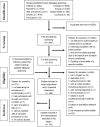Variation in the estimated prevalence of multimorbidity: systematic review and meta-analysis of 193 international studies
- PMID: 35487738
- PMCID: PMC9058768
- DOI: 10.1136/bmjopen-2021-057017
Variation in the estimated prevalence of multimorbidity: systematic review and meta-analysis of 193 international studies
Abstract
Objective: (1) To estimate the pooled prevalence of multimorbidity in all age groups, globally. (2) To examine how measurement of multimorbidity impacted the estimated prevalence.
Methods: In this systematic review and meta-analysis, we conducted searches in nine bibliographic databases (PsycINFO, Embase, Global Health, Medline, Scopus, Web of Science, Cochrane Library, CINAHL and ProQuest Dissertations and Theses Global) for prevalence studies published between database inception and 21 January 2020. Studies reporting the prevalence of multimorbidity (in all age groups and in community, primary care, care home and hospital settings) were included. Studies with an index condition or those that did not include people with no long-term conditions in the denominator were excluded. Retrieved studies were independently reviewed by two reviewers, and relevant data were extracted using predesigned pro forma. We used meta-analysis to pool the estimated prevalence of multimorbidity across studies, and used random-effects meta-regression and subgroup analysis to examine the association of heterogeneous prevalence estimates with study and measure characteristics.
Results: 13 807 titles were screened, of which 193 met inclusion criteria for meta-analysis. The pooled prevalence of multimorbidity was 42.4% (95% CI 38.9% to 46.0%) with high heterogeneity (I2 >99%). In adjusted meta-regression models, participant mean age and the number of conditions included in a measure accounted for 47.8% of heterogeneity in effect sizes. The estimated prevalence of multimorbidity was significantly higher in studies with older adults and those that included larger numbers of conditions. There was no significant difference in estimated prevalence between low-income or middle-income countries (36.8%) and high-income countries (44.3%), or between self-report (40.0%) and administrative/clinical databases (52.7%).
Conclusions: The pooled prevalence of multimorbidity was significantly higher in older populations and when studies included a larger number of baseline conditions. The findings suggest that, to improve study comparability and quality of reporting, future studies should use a common core conditions set for multimorbidity measurement and report multimorbidity prevalence stratified by sociodemographics.PROSPERO registration numberCRD42020172409.
Keywords: epidemiology; general medicine (see internal medicine); geriatric medicine.
© Author(s) (or their employer(s)) 2022. Re-use permitted under CC BY-NC. No commercial re-use. See rights and permissions. Published by BMJ.
Conflict of interest statement
Competing interests: None declared.
Figures




References
-
- World Health Organization . Ageing and health, 2018. Available: https://www.who.int/news-room/fact-sheets/detail/ageing-and-health [Accessed cited 2021 April 1].
-
- The Academy of Medical Sciences, . Multimorbidity: a priority for global health research 2018.
Publication types
MeSH terms
LinkOut - more resources
Full Text Sources
Medical
Miscellaneous
